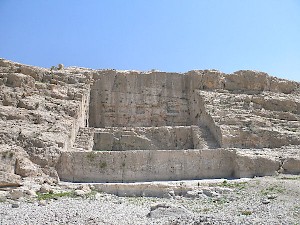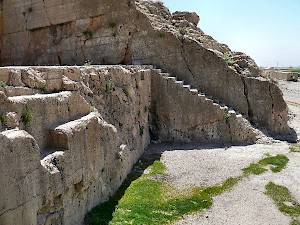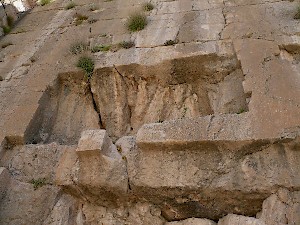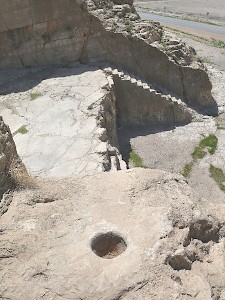Qadamgah
Q3412395Qadamgah: site of an Achaemenid water monument.

The rock-cut Achaemenid monument at Qadamgah was discovered in 1881 by H.L. Wells. It is located about 50 km southeast of Persepolis, at the southern extremity of the Kuh-e Rahmat mountain. The monument is carved in the body of a rocky cliff and consists of three superimposed rectangular platforms of equal width, approximately 20,10 m each. (It may be noted that "qadamgah" may be translated as "enclosure" or "platform".)

The lower platform lies above a now dry pool that used to be flooded by a spring. Its depth is 2,5m. It can be accessed by climbing and walking over the rocky surfaces beside the monument. No evidence of any frontal access - such as a stairway - was ever found, although this doesn't mean it never existed in the past. There are traces of pavement covering the whole surface of the floor, although, curiously, no pieces or even fragments of such pavement have ever been found in the immediate vicinity of the monument.
The second platform has a bigger surface, and could be accessed by the sides through two very damaged stairways (one at each side), also carved directly into the rock. Few steps remain; signs of multiple repairs can be seen. Using these stairs, one climbs directly to the upper platform, about four meters higher.

The upper platform has the biggest surface and dominates the two others. Its depth is 13 to 15 meters. Interestingly, the floor and walls show several rectangular niches that are between 10 and 30 cm deep. Above and beside the monument, several holes can be seen cut in the rock, mortises in which hoists were inserted, allowing to clear some heavy pieces of stones out of the site.
If the style and the carving technique of the monument are clearly Achaemenid, its function remained unclear until recently. Looking somehow like the royal tombs of Persepolis and Naqš-e Rustam, it was initially believed that the Qadamgah monument had a funeral function. The niches were considered to be repositories of bones. Because it lacked reliefs and other decorations, the tomb was believed to be unfinished.

However, a technical study by specialists of stone carving techniques and engineering, has recently made it clear that the poor rock quality was not recent and existed at the time the monument was made. Such friable and crispy rock was already in Achaemenid times known to be incompatible with the realization of a royal tomb. The recent study also showed that the multiple niches were in fact there to contain stones designed to repair the imperfections of the rock.
A religious function is now assumed. One argument is that the Kuh-e Rahmat was a holy mountain for the ancient Persians, another argument that a water pool was in the neighborhood. This allows us to think that the Qadamgah was a monument dedicated to a water cult, perhaps for Anahita.
Literature
- Jean-Claude Bessac, "Étude technique et interprétations du monument rupestre de Qadamgah (Fars)", in: Iranica Antiqua 42 (2007) 185-206.
- Rémy Boucharlat, "Le monument rupestre de Qadamgah (Fars) : essai d’interprétation", Iranica Antiqua 14 (1979) 163-166.